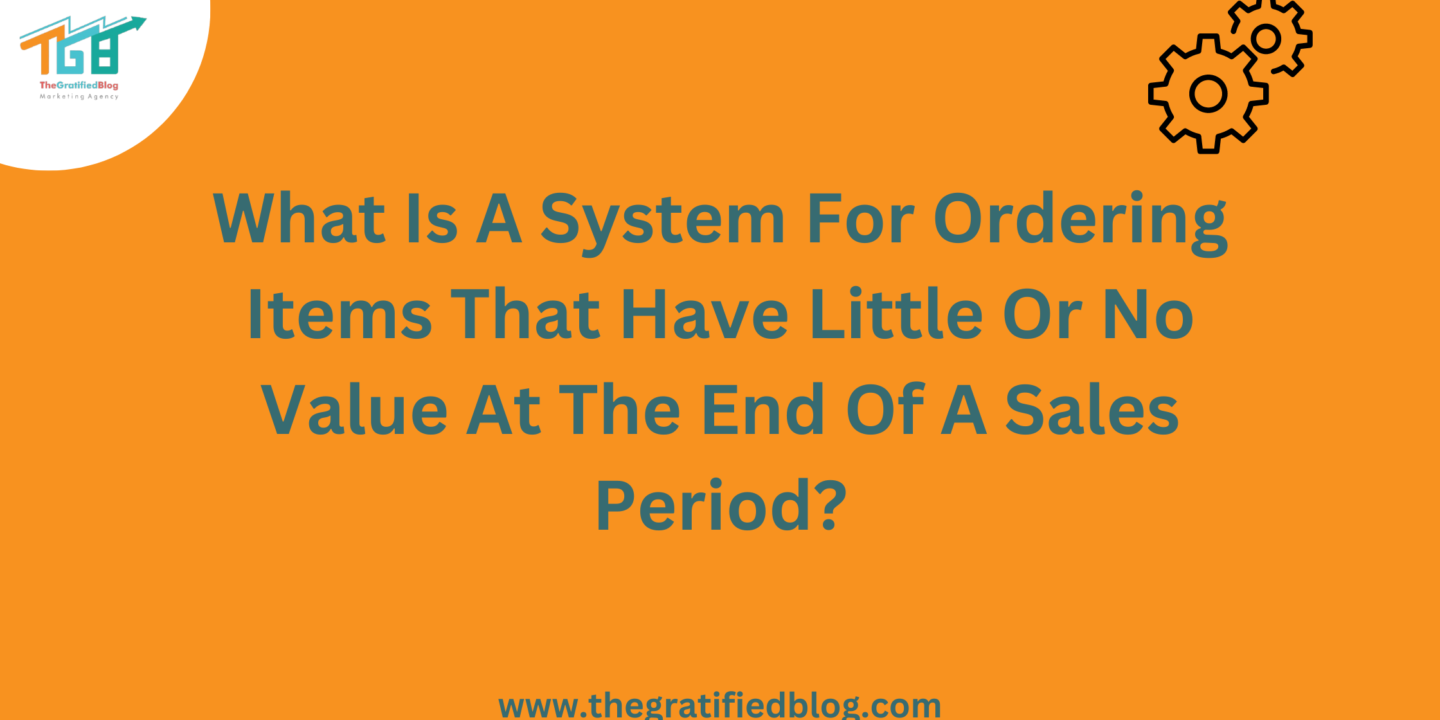
In the dynamic world of retail and commerce, businesses often grapple with a unique challenge: managing inventory items that hold little to no value at the end of a sales period. This perplexing scenario raises a crucial question: What is a system for ordering items with little or no value at the end of a sales period? As the sales cycle ebbs and flows, certain products may lose appeal, become outdated, or fail to resonate with consumers. The task of effectively handling these items is a complex puzzle that requires a strategic approach.

So, In this blog, we will deeply delve into the challenges presented by items losing value as sales periods come to an end; we will thoroughly explore the factors contributing to the presence of low-value items and carefully analyze various methods to create a robust system that successfully addresses this challenge.
So, let’s get started;
Understanding The Challenge Of Dealing With Items That Have Little Or No Value At The End Of A Sales Period

In the fast-moving business world, one big problem is handling things that become less valuable when a sales period ends. These things were thought to make money but can become complicated and uncertain. The main problem is making intelligent choices about these things even when they’re not worth much anymore.
Here are a few challenges that can come up when dealing with items that aren’t valuable at the end of a sales period:
Diminished Value Items
Items that become nearly worthless after a sales period can be affected by different things. These include people’s changing likes, new technology making products old, seasonal changes, and unexpected market changes. Something that used to be popular can lose its charm fast, leaving businesses with many things nobody wants anymore.
Inventory Strain
As these items lose value, they can put a lot of pressure on how a business handles its inventory. Managing inventory is like carefully walking on a tightrope – if items don’t sell, it’s a missed chance. Also, these items take up significant storage room that could be used for things people want to buy. That can cause problems like having too much stock, which uses up money and resources that could be used for better things.
Financial Implications
When businesses have items that don’t sell well, it can hurt their finances. They spend a lot of money making and advertising these things. But if they sell as expected, the business will retain money. To make matters worse, they might have to sell these items at much lower prices, reducing their profits. Sometimes, they might even have to throw these items away, which is like throwing away money.
Operational Inefficiencies
When businesses don’t handle low-value items well, it can cause problems beyond money. Employees spend too much time caring for these items instead of doing more important things. That wastes their time and stops them from doing their best work. It’s like using important people for not-so-important tasks, which slows progress and stops new ideas from coming in.
Now that we have a clear understanding of the challenges involved in handling items with limited or no value at the close of a sales period let’s shift our focus to the elements that contribute to the existence of low-value items.
Factors Contributing To Low-Value Items

When a sales period finishes, we often end up with items that have little worth. That happens for a variety of reasons. Some of these reasons include changes in what customers like, having too much stuff, and more. These factors make it tough to handle inventory well and show why having a good way of ordering things is essential. Let’s now look at some of these reasons that make items lose value.
Seasonal Trends

Seasonal trends play a significant role in the value of items as a sales period draws to a close. Certain products have inherent seasonality, meaning they are in high demand during specific times of the year and lose relevance outside those periods.
For instance, winter clothing items like heavy coats and sweaters may have limited appeal during summer. Businesses that need to anticipate and adjust their inventory levels accordingly may find themselves with excess stock of these items, leading to lower value and potential financial losses.
Changing Consumer Preferences
Consumer preferences are dynamic and can shift rapidly due to evolving lifestyles, cultural influences, and emerging trends. A once popular product may lose its appeal as consumer tastes change. Failure to adapt to these shifts can leave businesses with inventory that no longer resonates with their target audience.
For example, technological advancements can render products outdated, causing their value to plummet quickly.
Technological Advancements
The relentless march of technological progress can lead to items becoming obsolete faster than ever before. Products that rely on certain technologies may lose value as newer, more advanced alternatives hit the market.
That is particularly evident in industries such as electronics and gadgets. An item that was cutting-edge when introduced may become obsolete within a year, leaving businesses with inventory that is difficult to sell at a reasonable price.
Overstocking
Overstocking is a critical factor contributing to items with little or no value at the end of a sales period. It occurs when a business holds excessive inventory that cannot be sold within a reasonable timeframe. There are several reasons why overstocking can happen:
- Misjudging Demand
Businesses might misjudge the demand for a particular item, overestimating how much they need to order. That can happen due to poor forecasting methods, lack of accurate data, or reliance on historical patterns that no longer hold.
- Ineffective Inventory Management
Weak inventory management practices can result in overstocking. Businesses that need a proper system for tracking inventory levels, monitoring sales trends, and replenishing stock as required are more likely to have excess inventory.
- Supplier Pressure
In some cases, pressure from suppliers to meet minimum order quantities or take advantage of bulk discounts can lead to overstocking. Businesses might feel compelled to order more than they need to secure better pricing, only to find themselves with surplus inventory that loses value over time.
- Unforeseen Events
Unforeseen economic downturns, natural disasters, or sudden regulation changes can disrupt the demand for specific products. Businesses that have already ordered inventory based on a different market environment can have excess stock with little value in the changed circumstances.
- Lack of Flexibility
Businesses with rigid ordering and inventory management processes may need help to adapt to changing circumstances. A lack of flexibility can lead to overstocking as adjustments cannot be made quickly enough to match shifting demand.
Now that we understand the challenges that come with managing items of little value after a sales period, and we’ve also explored the reasons behind these low-value items, the focus shifts to addressing the central question: What is a system for ordering items that have little or no value at the end of a sales period?
This leads us to explore strategies to construct a system that efficiently oversees ordering such items.
Strategies For Developing An Effective System
Developing a robust system for ordering items with little or no value at the end of a sales period is critical in inventory management. To achieve this, businesses can leverage a combination of strategic approaches to make informed decisions, optimize resource allocation, and minimize losses.
Four key strategies stand out:
- data-driven decision-making,
- demand forecasting,
- dynamic pricing, and
- just-in-time inventory management.
Now, let’s explore each one of them in detail:
Data-Driven Decision-Making
Data-driven decision-making involves using sales data, historical trends, and other relevant metrics to inform ordering decisions. By analyzing patterns of demand and identifying trends, businesses can gain valuable insights into the performance of their inventory items.
This approach enables them to identify items losing value and adjust their ordering accordingly. Data-driven decision-making minimizes the risk of overstocking or understocking, leading to more precise inventory management.
Demand Forecasting
Demand forecasting is a proactive strategy that predicts future demand based on historical data, market trends, and external factors. By employing statistical methods, machine learning algorithms, and market research, businesses can anticipate shifts in demand for specific items.
That enables them to adjust their ordering quantities and timing to meet expected demand. By accurately predicting demand, businesses can prevent accumulating items that may lose value over time.
Dynamic Pricing
Dynamic pricing is a strategy that involves adjusting the prices of items based on real-time demand and supply conditions. For items with diminishing value, businesses can implement dynamic pricing to encourage faster sales before the end of a sales period.
By gradually reducing prices as the period progresses, businesses incentivize customers to make purchases, thus reducing the risk of being left with unsold inventory. Dynamic pricing enhances revenue generation while also preventing items from losing significant value.
Just-In-Time Inventory Management
Just-in-time (JIT) inventory management is a strategy focused on minimizing inventory levels to reduce holding costs and waste. This approach involves ordering and receiving inventory only when it is needed to fulfill customer orders. In the context of items with little value, JIT management can help prevent overstocking by ensuring inventory levels closely align with actual demand. This approach requires a well-coordinated supply chain and accurate demand forecasting.
- The JIT Approach In Detail
Just-in-time inventory management works by maintaining lean inventory levels and synchronizing the supply chain to match customer demand closely. In the context of items with little or no value at the end of a sales period, JIT management is precious. Here’s how it works:
- Accurate Demand Forecasting
JIT relies heavily on accurate demand forecasting. Businesses must predict demand trends precisely to ensure they have the proper inventory. This approach prevents overstocking and minimizes holding costs for items that may lose value quickly.
- Lean Inventory Levels
JIT aims to minimize inventory levels to reduce storage costs and the risk of unsold items. For low-value items, maintaining lean inventory prevents tying up resources in products that offer little return on investment.
- Timely Replenishment
With JIT, businesses order inventory only as needed. That prevents the accumulation of items that may lose value over time. Instead of ordering in bulk and risking overstocking, businesses replenish inventory just in time to fulfill incoming orders.
- Reduced Holding Costs
Holding costs, such as storage, insurance, and maintenance expenses, can be significant. JIT minimizes these costs by ensuring inventory is on hand for the shortest possible time, optimizing resource allocation.
FAQs
Q1: What Is A System For Ordering Items With Little Or No Value At The End Of A Sales Period?
A:This system aims to optimize inventory management for items expected to have reduced or negligible value after a sales period. Businesses can minimize losses and maximize profitability by efficiently ordering and managing these items.
Q2: How Does This System Differ From Traditional Inventory Management Systems?
A: Traditional inventory management systems focus on balancing demand and supply. In contrast, the system for items with little value at the end of a sales period explicitly addresses the unique challenge of handling items that may become obsolete or less valuable over time. It involves strategic planning to avoid overstocking such items.
Q3: What Types Of Businesses Benefit From Implementing This System?
A: Businesses that deal with seasonal or trend-dependent products, perishable goods, or technological items prone to rapid depreciation can benefit from this system. Retailers, manufacturers, and distributors facing challenges with surplus inventory can find value in implementing a tailored ordering system.
Conclusion
Now that you have a solution for your query, what is a system for ordering items with little or no value at the end of a sales period? Why not implement the abovementioned strategies to generate orders?
If you still have questions about this topic, please drop them in the comments section. We’ll be delighted to provide you with answers.
Thanks for reading 🙂








No Comments